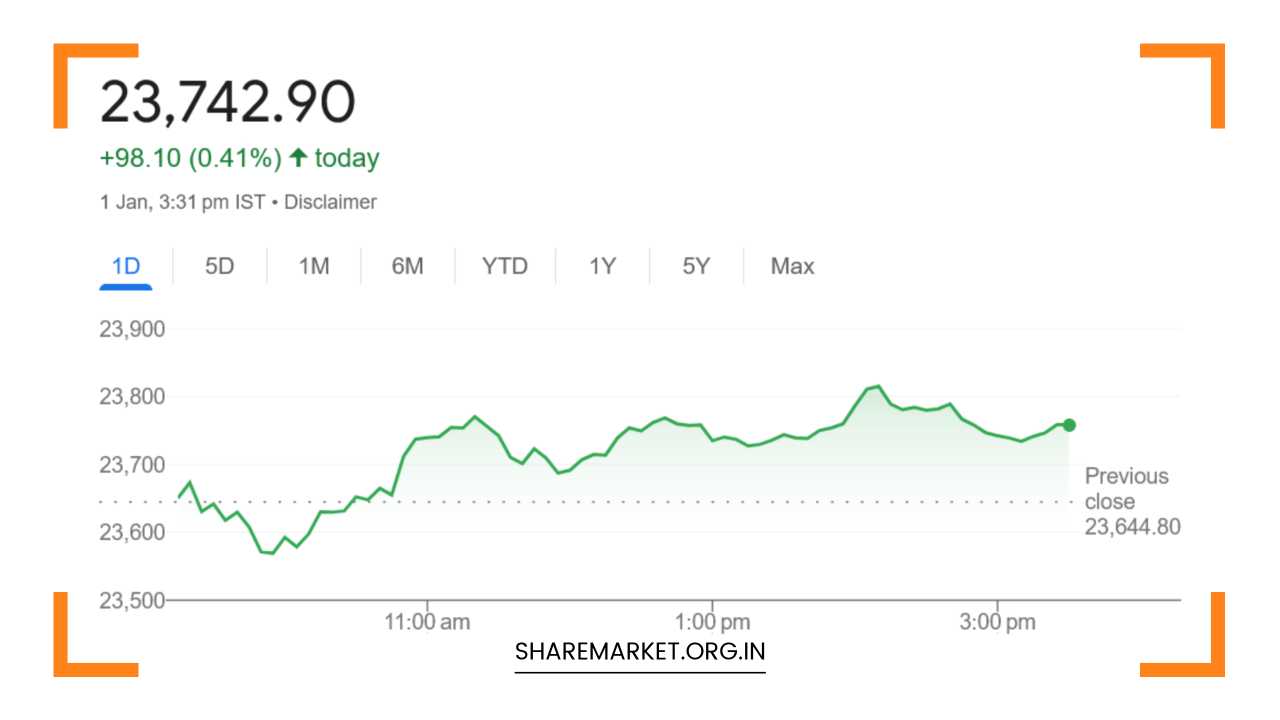Sensex Gain 368 Points. Nifty at 23,742; Tomorrow Nifty Prediction

Tomorrow Nifty Prediction
Sensex and Nifty Close with Gains: What to Expect on January 2nd and Beyond
Equity Market Overview: The Indian stock market saw a positive start to 2025, with both major indices, Sensex and Nifty, ending the first trading session of the year on a high note.
The Nifty index reached a significant milestone, crossing the 23,700 mark, while the Sensex added 368.40 points to close at 78,507.41.
Despite some early-day pressure, the broader market ended the session with robust gains, signaling potential optimism for the upcoming trading days.
As we move into the second trading day of January, the outlook remains cautiously optimistic, but there are signs of ongoing consolidation that could shape the market’s trajectory in the short term.
Market Performance on January 1:
The Nifty closed at 23,742.90, up by 98.10 points, or 0.41%, while the Sensex rose 368.40 points, or 0.47%, to end at 78,507.41.
The breadth of the market remained largely positive, with 2,642 stocks advancing, 1,177 declining, and 83 remaining unchanged.
The BSE Midcap Index gained 0.5%, and the Smallcap Index rose by 1%, indicating that the rally was broad-based across different market segments.
Among the key sectors, Auto, Power, and Capital Goods emerged as the top performers, with each index rising by approximately 1%.
These gains were led by stocks such as Maruti Suzuki, M&M, Bajaj Finance, L&T, and Eicher Motors, which helped buoy the market.
On the other hand, the Metal and Realty sectors saw weakness, with major stocks like Tata Steel, Hindalco Industries, ONGC, and Adani Ports contributing to the losses.
Technical Outlook for Nifty:
Nifty’s performance on January 1 was largely driven by a positive divergence in the Relative Strength Index (RSI), a key technical indicator that suggests the index is gaining upward momentum.
According to Aditya Gaggar, Director at Progressive Shares, this RSI divergence indicates that Nifty could see further upside, but it needs to break through crucial resistance levels to gain additional strength.
Currently, 23,850-23,900 is seen as a key resistance zone for the Nifty, with the 200-day moving average (DMA) also residing within this range.
A breakout above this level could set the stage for a more sustained rally, potentially pushing Nifty towards higher levels.
On the downside, immediate support is pegged at 23,560, which should hold to prevent a deeper correction. If the Nifty breaches this support, we could see further consolidation or even a pullback to lower levels.
However, as Gaggar points out, Nifty’s continued consolidation could offer opportunities for traders to focus on stocks that show relative strength.
Select stocks, particularly in sectors like automobiles and capital goods, may outperform the broader index as the market remains range-bound.
Range-bound Trading in the Short-Term:
While the market showed promise on January 1, Anand James, Head of Research at Geojit Financial Services, remains cautious about an immediate breakout.
He notes that although the Nifty has not yet picked up substantial momentum, it is likely to trade within a tight range in the near term.
According to James, the key range for Nifty in the short term is between 23,710 and 23,580. A break below 23,580 could trigger a deeper correction, while a move above 23,710 could set the stage for a fresh rally.
James also mentions that if the market were to surprise on the upside, it could eventually test the 24,025 level.
However, he believes the probability of such an event occurring in the immediate term is low, suggesting that market participants should remain cautious and wait for confirmation of a breakout.
Stock-Specific Strategy for Investors:
As Ajit Mishra, Vice President of Religare Broking, mentions, Nifty’s second week of consolidation is likely to continue, with indicators showing no immediate signs of a decisive breakout.
Mishra advises traders and investors to adopt a stock-specific strategy during this period, focusing on individual stocks that are likely to outperform.
Given the ongoing consolidation in the broader market, stock selection becomes crucial. Pharma, Healthcare, FMCG, and Energy sectors present potential opportunities.
The pharma sector, in particular, has shown resilience in the past and continues to offer selective buying opportunities, especially in the context of increasing global healthcare demand.
Similarly, the FMCG sector, known for its defensive nature, could benefit from stable consumption trends, making it an attractive space for investors seeking relatively safe bets in a volatile market.
In addition to sector-specific stock picks, Mishra also highlights the importance of focusing on stocks with strong momentum.
These stocks often outperform during consolidation phases, where market breadth remains mixed, and sectors take turns leading the market.
Investors should look for stocks with positive earnings growth, strong technical setups, and strong institutional backing.
Key Levels to Watch for Nifty and Sensex:
Looking ahead to January 2, 2025, traders and investors will keep an eye on several technical levels to gauge the market’s direction:
- Nifty Resistance: The immediate resistance for Nifty is seen at the 23,850-23,900 range. A breakout above this level could trigger a fresh rally, possibly pushing Nifty toward the 24,025 level.
- Nifty Support: On the downside, 23,560 serves as a critical support level. If Nifty breaks below this level, it could signal further consolidation or a correction towards lower levels.
- Sensex Resistance: Sensex faces resistance near the 78,800-79,000 zone. A decisive break above this could open the door for further gains, with the next target being around 79,500-80,000.
- Sensex Support: On the downside, 78,000-77,800 is likely to act as strong support for the Sensex. A breach below these levels would indicate potential weakness in the index.
Global Market Influences and Other Factors to Consider:
While domestic factors will continue to influence market direction, global cues will also play an important role in shaping market sentiment.
The performance of US and European markets, particularly in light of macroeconomic data and corporate earnings releases, could have a ripple effect on the Indian stock market.
Additionally, movements in crude oil prices, geopolitical tensions, and domestic economic data, such as inflation and GDP growth, will also contribute to market volatility.
Final Remarks
The Indian equity market’s strong performance on January 1 is a positive sign, but the ongoing consolidation phase indicates that caution is warranted in the short term.
Key levels for both Nifty and Sensex will be crucial in determining the next move for the market. Traders and investors should focus on stock-specific opportunities, particularly in sectors with strong momentum, such as autos, power, and healthcare.
As the market continues to digest recent gains, a breakout or deeper consolidation could determine the broader trend for the coming weeks.

















